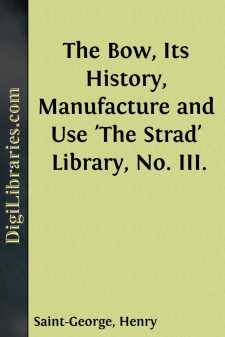Categories
- Antiques & Collectibles 13
- Architecture 36
- Art 48
- Bibles 22
- Biography & Autobiography 813
- Body, Mind & Spirit 142
- Business & Economics 28
- Children's Books 14
- Children's Fiction 11
- Computers 4
- Cooking 94
- Crafts & Hobbies 4
- Drama 346
- Education 46
- Family & Relationships 57
- Fiction 11829
- Games 19
- Gardening 17
- Health & Fitness 34
- History 1377
- House & Home 1
- Humor 147
- Juvenile Fiction 1873
- Juvenile Nonfiction 202
- Language Arts & Disciplines 88
- Law 16
- Literary Collections 686
- Literary Criticism 179
- Mathematics 13
- Medical 41
- Music 40
- Nature 179
- Non-Classifiable 1768
- Performing Arts 7
- Periodicals 1453
- Philosophy 64
- Photography 2
- Poetry 896
- Political Science 203
- Psychology 42
- Reference 154
- Religion 513
- Science 126
- Self-Help 84
- Social Science 81
- Sports & Recreation 34
- Study Aids 3
- Technology & Engineering 59
- Transportation 23
- Travel 463
- True Crime 29
The Bow, Its History, Manufacture and Use 'The Strad' Library, No. III.
Categories:
Description:
Excerpt
PREFACE.
It has always appeared to me a curious thing that the bow, without which the fiddle could have no being, should have received so scant attention, not alone from the community of fiddlers, but also from writers on the subject. I only know of one book in which the subject is adequately handled. Out of every twenty violinists who profess to some knowledge of the various types of Cremonese and other fiddles of repute and value, barely three will be met with who take a similar interest in the bow beyond knowing a good one, or rather one that suits their particular physique, when playing with it. They are all familiar with the names of Dodd and Tourte, but it is seldom that their knowledge extends beyond the names. As for a perception of the characteristics of bows as works of art, which is the standard of the fiddle connoisseur, it hardly has any existence outside the small circle of bow makers. Of the large number of undoubted fiddle experts now in London, but a small proportion profess to any similar knowledge of bows, and of these there are but few who can be credited with real authority in the matter.
It is, therefore, with the object of bringing the bow into more general notice that this little book has been written, and, to drop into the good old prefatory style, if I succeed in arousing the interest of but one violinist in the bow for itself, and apart from its work, my efforts will not have been in vain.
My most hearty thanks are due to those who have so kindly assisted me in my work. To Messrs. W. E. Hill and Sons, Mr. E. Withers, Mr. F. W. Chanot, Mr. J. Chanot, and Messrs. Beare, Goodwin and Co., for the loan of valuable bows for the purpose of illustration, and Mr. A. Tubbs, who, in addition to similar favours, most kindly placed much of his valuable time at my disposal, and very patiently helped me to a sufficient understanding of the bow maker's craft for the purpose of collecting materials for the second part of the book.
The third part, in which I treat of the use of the bow, I have purposely avoided making a systematic handbook of bowing technique, for to handle that subject as exhaustively as I should wish would require a separate volume. As stated in Chapter XIV., that portion of the book is addressed almost exclusively to teachers, and in the few cases where I have gone into questions of technique it has been limited to those points that appear to be most neglected or misunderstood by the generality of teachers.
"Anything that is worth doing is worth doing well" is a maxim that teachers should hold up to themselves and their pupils, and this reminds me of an exhortation to that effect in "Musick's Monument," that quaint and pathetic book of Thomas Mace (1676) with which I cannot do better than end my already too extensive preamble.
"Now being Thus far ready for Exercise, attempt the Striking of your Strings; but before you do That, Arm yourself with Preparative Resolutions to gain a Handsome—Smooth—Sweet—Smart—Clear—Stroak; or else Play not at all."


